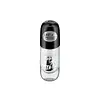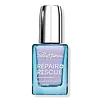What's inside
What's inside
 Key Ingredients
Key Ingredients

 Benefits
Benefits

 Concerns
Concerns

 Ingredients Side-by-side
Ingredients Side-by-side

Ethyl Acetate
PerfumingButyl Acetate
MaskingNitrocellulose
Acrylates/Hydroxyesters Acrylates Copolymer
Acetyl Tributyl Citrate
MaskingIsopropyl Alcohol
SolventTosylamide/Epoxy Resin
N-Butyl Alcohol
PerfumingAcetylated Hydrogenated Castor Glyceride
Stearalkonium Hectorite
Gel FormingBenzophenone-1
UV AbsorberCaprylic/Capric Triglyceride
MaskingMethyl Methacrylate Crosspolymer
Dimethicone
EmollientApium Graveolens Seed Extract
AntioxidantCitric Acid
BufferingWater
Skin ConditioningAdipic Acid/Neopentyl Glycol/Trimellitic Anhydride Copolymer
Amethyst Extract
Skin ConditioningBiotin
AntiseborrhoeicTocopherol
AntioxidantLeuconostoc/Radish Root Ferment Filtrate
AntimicrobialCI 77891
Cosmetic ColorantCI 15880
Cosmetic ColorantCI 60725
Cosmetic ColorantCI 15850
Cosmetic ColorantCI 77510
Cosmetic ColorantEthyl Acetate, Butyl Acetate, Nitrocellulose, Acrylates/Hydroxyesters Acrylates Copolymer, Acetyl Tributyl Citrate, Isopropyl Alcohol, Tosylamide/Epoxy Resin, N-Butyl Alcohol, Acetylated Hydrogenated Castor Glyceride, Stearalkonium Hectorite, Benzophenone-1, Caprylic/Capric Triglyceride, Methyl Methacrylate Crosspolymer, Dimethicone, Apium Graveolens Seed Extract, Citric Acid, Water, Adipic Acid/Neopentyl Glycol/Trimellitic Anhydride Copolymer, Amethyst Extract, Biotin, Tocopherol, Leuconostoc/Radish Root Ferment Filtrate, CI 77891, CI 15880, CI 60725, CI 15850, CI 77510
Ingredients Explained
These ingredients are found in both products.
Ingredients higher up in an ingredient list are typically present in a larger amount.
Acetyl Tributyl Citrate is a fragrance.
We don't have a description for Adipic Acid/Neopentyl Glycol/Trimellitic Anhydride Copolymer yet.
We don't have a description for Butyl Acetate yet.
Ethyl Acetate is a fragrance.
Isopropyl Alcohol is more commonly known as rubbing alcohol. It is most commonly used as a solvent, meaning it helps other ingredients dissolve.
This ingredient is an astringent alcohol. Astringent alcohols may also irritate skin as they high amounts may strip away your skin's natural oils.
Other types of astringent alcohols include:
According to the National Rosacea Society based in the US, you should be mindful of products with these alcohols in the top half of ingredients.
Any type of sanitizing product will have high amounts of alcohol to help kill bacteria and viruses.
Learn more about Isopropyl AlcoholN-Butyl Alcohol is a fragrance.
We don't have a description for Nitrocellulose yet.
Tocopherol (also known as Vitamin E) is a common antioxidant used to help protect the skin from free-radicals and strengthen the skin barrier. It's also fat soluble - this means our skin is great at absorbing it.
Vitamin E also helps keep your natural skin lipids healthy. Your lipid skin barrier naturally consists of lipids, ceramides, and fatty acids. Vitamin E offers extra protection for your skin’s lipid barrier, keeping your skin healthy and nourished.
Another benefit is a bit of UV protection. Vitamin E helps reduce the damage caused by UVB rays. (It should not replace your sunscreen). Combining it with Vitamin C can decrease sunburned cells and hyperpigmentation after UV exposure.
You might have noticed Vitamin E + C often paired together. This is because it is great at stabilizing Vitamin C. Using the two together helps increase the effectiveness of both ingredients.
There are often claims that Vitamin E can reduce/prevent scarring, but these claims haven't been confirmed by scientific research.
Learn more about TocopherolWater. It's the most common cosmetic ingredient of all. You'll usually see it at the top of ingredient lists, meaning that it makes up the largest part of the product.
So why is it so popular? Water most often acts as a solvent - this means that it helps dissolve other ingredients into the formulation.
You'll also recognize water as that liquid we all need to stay alive. If you see this, drink a glass of water. Stay hydrated!
Learn more about Water